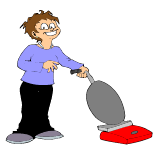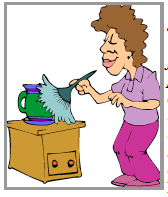The Environmental Health Center offers the following “safer solutions.”
| For This: | Try This: |
| Ants | Red chili powder at their entrance point |
| Chrome polish | Apple cider vinegar |
| Dish detergent | 1/2 cup baking soda + liquid detergent |
| Flies | Well watered bowl of basil |
| Ink spot remover | Cold water +1 tablespoon cream of tarter + 1 tablespoon lemon juice |
| Moth Repellant | Cedar chips enclosed in cotton sachets |
| Pet odor removal | Cider vinegar |
| Roach repellant | Chopped bay leaves and cucumber skins |
| Window cleaner | 2 tablespoons vinegar in 1 quart warm water |
| Air Freshener | Use herbal bouquets, pure vanilla on a cotton ball, or simmer cinnamon and cloves |
| Mold and Mildew | *Bleach |
| Drain Cleaner | 1/2 cup baking soda + 1/2 cup vinegar, wait a few minutes, then 2 quarts boiling water; repeat process |
| Rusty bolt/nut Remover | Carbonated beverage |
*Never use chlorine bleach on nylon carpeting.
The article containing the above information (“Making Your Home Environment More Healthy!”) also suggested baking soda as a “Rug/Carpet Cleaner.” NOT a good idea.
There are also grocery store products for pet urine odor control in carpeting that contain baking soda. Again, NOT a good idea.
Reason: First of all, baking soda is not a good overall cleaner for carpeting, because it cannot cut the broad variety of soils that accumulate. It will work on some soils, not on others. Second, the substance is extremely difficult to get out of carpeting. And, once used, when your carpet is cleaned, the baking soda causes pile yarn to become stiff.
 And, in the advertisement, the person demonstrating the device rolls it back and forth over carpeting in the exercising process. Rolling wheels or casters of any type or size—from desk chairs, roller skates to wheelchairs— over carpeting produces a rippling effect in the carpet backing. In time, repeating this practice will cause the backing to separate, ruining the carpeting. When wheels are unavoidable, the carpeting should be not be installed over pad but glued directly to the subfloor. Of course, with desk chairs, the problem can be eliminated by simply placing a desk -chair pad between the chair and the carpeting.
And, in the advertisement, the person demonstrating the device rolls it back and forth over carpeting in the exercising process. Rolling wheels or casters of any type or size—from desk chairs, roller skates to wheelchairs— over carpeting produces a rippling effect in the carpet backing. In time, repeating this practice will cause the backing to separate, ruining the carpeting. When wheels are unavoidable, the carpeting should be not be installed over pad but glued directly to the subfloor. Of course, with desk chairs, the problem can be eliminated by simply placing a desk -chair pad between the chair and the carpeting.

